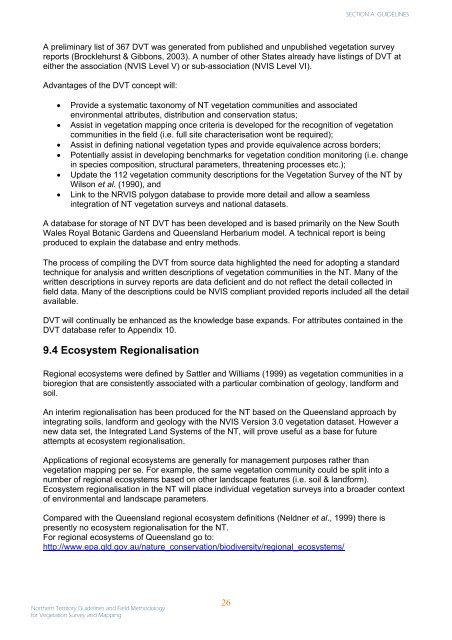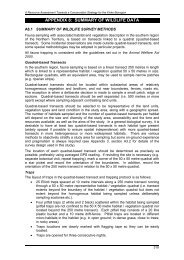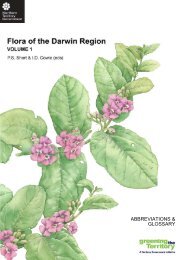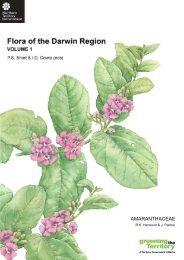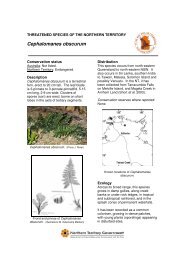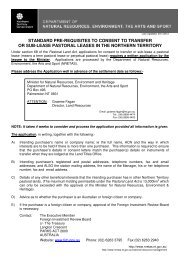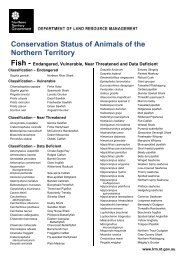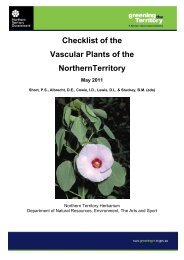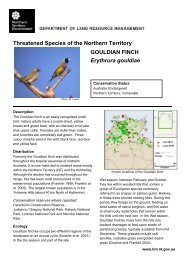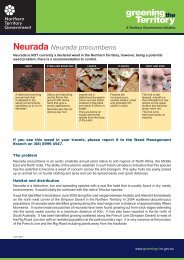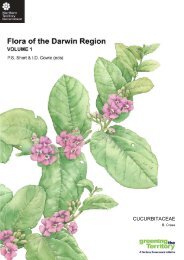Guidelines and Field Methodology for Vegetation Survey and Mapping
Guidelines and Field Methodology for Vegetation Survey and Mapping
Guidelines and Field Methodology for Vegetation Survey and Mapping
Create successful ePaper yourself
Turn your PDF publications into a flip-book with our unique Google optimized e-Paper software.
SECTION A: GUIDELINES<br />
A preliminary list of 367 DVT was generated from published <strong>and</strong> unpublished vegetation survey<br />
reports (Brocklehurst & Gibbons, 2003). A number of other States already have listings of DVT at<br />
either the association (NVIS Level V) or sub-association (NVIS Level VI).<br />
Advantages of the DVT concept will:<br />
• Provide a systematic taxonomy of NT vegetation communities <strong>and</strong> associated<br />
environmental attributes, distribution <strong>and</strong> conservation status;<br />
• Assist in vegetation mapping once criteria is developed <strong>for</strong> the recognition of vegetation<br />
communities in the field (i.e. full site characterisation wont be required);<br />
• Assist in defining national vegetation types <strong>and</strong> provide equivalence across borders;<br />
• Potentially assist in developing benchmarks <strong>for</strong> vegetation condition monitoring (i.e. change<br />
in species composition, structural parameters, threatening processes etc.);<br />
• Update the 112 vegetation community descriptions <strong>for</strong> the <strong>Vegetation</strong> <strong>Survey</strong> of the NT by<br />
Wilson et al. (1990), <strong>and</strong><br />
• Link to the NRVIS polygon database to provide more detail <strong>and</strong> allow a seamless<br />
integration of NT vegetation surveys <strong>and</strong> national datasets.<br />
A database <strong>for</strong> storage of NT DVT has been developed <strong>and</strong> is based primarily on the New South<br />
Wales Royal Botanic Gardens <strong>and</strong> Queensl<strong>and</strong> Herbarium model. A technical report is being<br />
produced to explain the database <strong>and</strong> entry methods.<br />
The process of compiling the DVT from source data highlighted the need <strong>for</strong> adopting a st<strong>and</strong>ard<br />
technique <strong>for</strong> analysis <strong>and</strong> written descriptions of vegetation communities in the NT. Many of the<br />
written descriptions in survey reports are data deficient <strong>and</strong> do not reflect the detail collected in<br />
field data. Many of the descriptions could be NVIS compliant provided reports included all the detail<br />
available.<br />
DVT will continually be enhanced as the knowledge base exp<strong>and</strong>s. For attributes contained in the<br />
DVT database refer to Appendix 10.<br />
9.4 Ecosystem Regionalisation<br />
Regional ecosystems were defined by Sattler <strong>and</strong> Williams (1999) as vegetation communities in a<br />
bioregion that are consistently associated with a particular combination of geology, l<strong>and</strong><strong>for</strong>m <strong>and</strong><br />
soil.<br />
An interim regionalisation has been produced <strong>for</strong> the NT based on the Queensl<strong>and</strong> approach by<br />
integrating soils, l<strong>and</strong><strong>for</strong>m <strong>and</strong> geology with the NVIS Version 3.0 vegetation dataset. However a<br />
new data set, the Integrated L<strong>and</strong> Systems of the NT, will prove useful as a base <strong>for</strong> future<br />
attempts at ecosystem regionalisation.<br />
Applications of regional ecosystems are generally <strong>for</strong> management purposes rather than<br />
vegetation mapping per se. For example, the same vegetation community could be split into a<br />
number of regional ecosystems based on other l<strong>and</strong>scape features (i.e. soil & l<strong>and</strong><strong>for</strong>m).<br />
Ecosystem regionalisation in the NT will place individual vegetation surveys into a broader context<br />
of environmental <strong>and</strong> l<strong>and</strong>scape parameters.<br />
Compared with the Queensl<strong>and</strong> regional ecosystem definitions (Neldner et al., 1999) there is<br />
presently no ecosystem regionalisation <strong>for</strong> the NT.<br />
For regional ecosystems of Queensl<strong>and</strong> go to:<br />
http://www.epa.qld.gov.au/nature_conservation/biodiversity/regional_ecosystems/<br />
Northern Territory <strong>Guidelines</strong> <strong>and</strong> <strong>Field</strong> <strong>Methodology</strong><br />
<strong>for</strong> <strong>Vegetation</strong> <strong>Survey</strong> <strong>and</strong> <strong>Mapping</strong><br />
26


